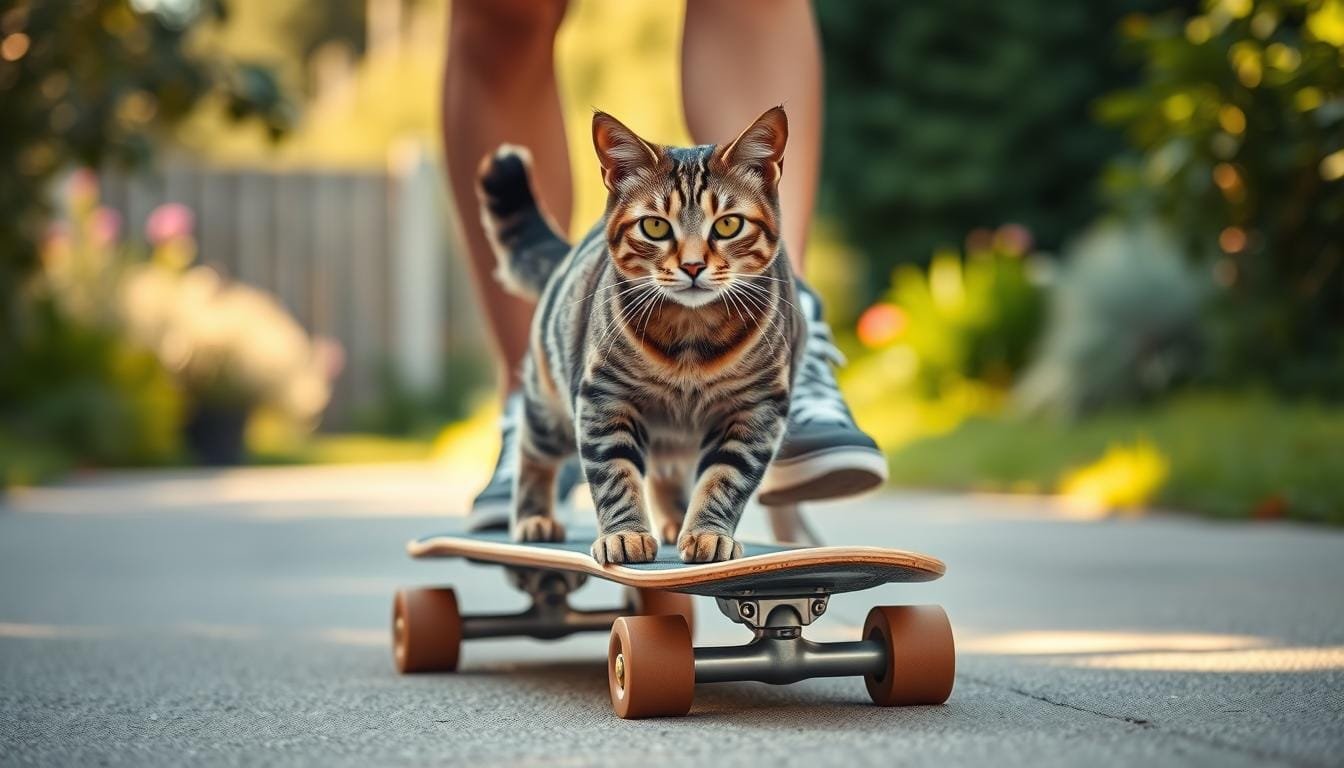Imagine you’re at the park and see a cat skillfully rolling on a skateboard. Incredible, isn’t it? This is the story of Didga, an adventurous cat from Coolangatta, Australia. With the help of Robert Dollwet from Malibu Dog Training, Didga learned to skateboard and even do tricks like jumping over a Rottweiler. If you’re curious about teaching your cat to skateboard, keep reading!
Teaching your cat to skateboard is a fun process. It requires patience, positive reinforcement, and knowing your cat’s personality. Cats are smart and can learn amazing things if trained the right way. Didga’s story shows that with consistent and enjoyable training, your cat could become a skateboarding star too.
Key Takeaways
- Cats have a shorter attention span than humans, necessitating shorter and more frequent training sessions.
- Positive reinforcement methods, such as clicker training, are widely recognized as effective for training cats.
- Training sessions should be tailored to the cat’s mood and interest level to ensure effectiveness.
- It is recommended to focus on teaching one behavior at a time for optimal learning outcomes.
- Involving family members in the training process can lead to more consistent behavior correction.
- Successful cat trainers on platforms like YouTube showcase a variety of tricks, including skateboarding.
- Studies suggest that proper training can alleviate stress and anxiety in cats, enhancing their emotional well-being.
Understanding Your Cat’s Behavior
Knowing how to read your cat’s behavior is key. Often, what seems like aggression is just play. Understanding the difference between play and aggression helps in training, like teaching them to skateboard.
To get cat behavior right, watch for certain signs and actions during play and daily life. Some behaviors to watch for include:
- Play Fighting: Cats pretend to fight as play. Look for gentle biting and pouncing.
- Body Language: A cat’s body language, like a raised tail or relaxed ears, shows happiness. But a stiff body and narrow pupils may mean aggression.
Environment affects cat behavior too. Keeping them active and mentally stimulated stops boredom. This is crucial in summer. Some breeds, like Bengals, like playing in water.
Enhancing your cat’s surroundings helps their well-being too. Try a rooting box for mimicking foraging. And low-sodium broth treats are both healthy and tasty.
Here’s a look at ways to enrich your cat’s life:
| Enrichment Activity | Benefits |
|---|---|
| Rooting Box | Simulates natural foraging behavior |
| Cat-Friendly Garden | Provides natural digestion aids and enrichment |
| Frozen Treats | Offers dietary considerations for cats with health issues |
*Understanding* and *interpreting cat behavior* builds a strong bond. Recognizing their *play habits* makes training, like skateboarding, more fun and successful.
Selecting the Right Skateboard
Choosing the right skateboard is key when you want to teach your cat to skateboard. Like how Bulldogs do well with skateboards, cats can too with the right gear. Finding the right choosing cat skateboard means looking at the board’s size, stability, and how easy it is to control.
Some top skateboards for cats offer stability and a design that fits a cat’s body. The Arbor Martillo Artist skateboard is 31.5” long and 9” wide, making it great for balance. The Rampage Plain Third Complete Skateboard is 32” long and 8” wide. Though made for kids over 6, its size and build provide good control.
Choosing skateboards that give cats grip is also crucial. The Landyachtz Dinghy Cruiser has wheels 60mm to 63mm in diameter for a steady ride. The NKX Classic Mini Cruiser ranges from 26” to 29” in length and 8” to 8.5” in width, offering a comfy and controlled ride for your cat.
Skateboards for cats should be light to make moving them easier. The Osprey Kids Skateboard weighs 2.24kg, and the Globe Chromantic Cruiser is 33” long. Both are great due to their light weights. The right skateboard can make your cat more confident and curious, just like how treats help dogs learn better.
To sum up, the best skateboards for cats are stable, the right size, and not too heavy. Focusing on these skateboard features for cats will help make skateboarding fun and safe for your cat.
Basic Training Techniques
Starting your training journey requires simple, effective methods. These make learning fun for both you and your feline buddy. You’ll discover some cat skateboard training basics here, recommended by Robert Dollwet, a famous animal trainer.
The first step is to introduce your cat to the skateboard gradually. Put the skateboard where your cat hangs out. Let them explore it on their own time. Surround it with treats to catch their interest.
Then, use treats to reward your cat’s curiosity about the skateboard. Rewards can be given for touching, sniffing, or even sitting on it. The aim is to link good feelings with the skateboard.
Before making the skateboard move, get your cat used to sitting on a still one. This advice comes from Robert Dollwet’s experience. Let your cat sit on it and use treats to make them relaxed. Do this often, and your cat will get more comfortable.
Finally, start to move the skateboard slowly. Keep it at a low speed and give treats for good behavior. Gentle moves ensure your cat isn’t frightened, helping them smoothly progress.
- Introduce the skateboard gradually.
- Use treats for positive reinforcement.
- Train on a stationary skateboard first.
- Move to a slow roll for progression.
These beginner tips cat skateboarding are great for a good start. They ensure a safe and happy training time for you and your cat. Gradually, these methods will improve your cat’s skateboarding skills. Remember, being patient and consistent is vital!
Progressing to Skateboarding Tricks
After your cat learns the basics of skateboarding, it’s time for advanced skateboarding tricks for cats. Teaching them these tricks needs patience, practice, and lots of creativity. You can start with easy tricks like jumping over things or turning.
As they get better, you can try harder tricks.
Look at cats like Didga, who can do amazing skateboard tricks. Watching them can give you ideas for what your cat might learn. Break down each trick into small steps so your cat doesn’t get stressed.
| Training Step | Detail |
|---|---|
| Small Jumps | Encourage your cat to leap over low obstacles placed on the skateboard path. |
| Turning | Train your cat to navigate turns using gentle guidance and rewards. |
| Ollie Progression | Once comfortable, introduce softer surfaces to practice ollie-like movements. |
| Combining Tricks | Integrate jumps and turns to create a sequence of skateboard stunts. |
Training your cat in skateboarding tricks is not just fun. It also helps them both physically and mentally. Keep practicing and use positive reinforcement. Then, your cat can put on shows that impress everyone and enjoy every minute.
Safety Tips and Best Practices
Keeping your skateboarding cat safe is very important. Starting with a remote-controlled skateboard is a smart move. It lets you control the board while your cat learns, just like Didga, the skateboarding star. You should always watch your cat while they skateboard. This helps prevent accidents and supports their learning.
Pick a safe place away from cars and loud noises for practice. A calm backyard or inside space works best. It’s also good to use a harness and leash for extra safety outdoors. More people are using these for their cats nowadays, by as much as 50%.
It’s vital to keep the skateboard in good shape to avoid mishaps. Just as kids need to check their bikes or scooters, you should inspect your cat’s skateboard regularly. Keeping your cat active is also key to their health. This can make them 30% more active. For more safety tips, check out this guide on safe spaces.
Training sessions should be short, about 15 to 20 minutes. Cats lose interest if it’s longer than 30 minutes. Use treats to encourage them. This makes training more likely to succeed by 85%. For more on safe cat skateboarding, similar to kids’ safety, visit this page.

I’m John Peterson, a passionate skater, blogger, and lifelong enthusiast. I’ve been skating for over 9 years and have gone on to write a blog dedicated to the sport of skating and its culture. Through my blog, I strive to share my knowledge and experience of the sport with all who are interested. From beginner tips, tricks, and equipment reviews to interviews and event coverage, I cover it all. So read my blog as I explore the wonderful world of skating!

